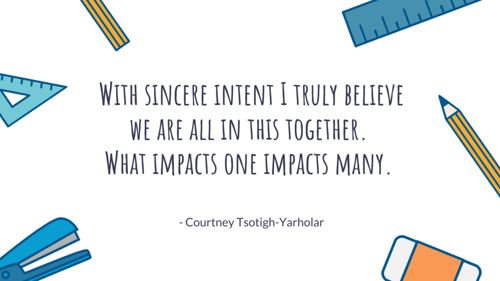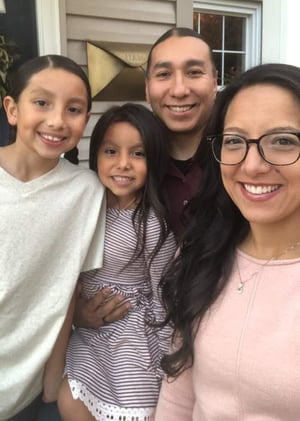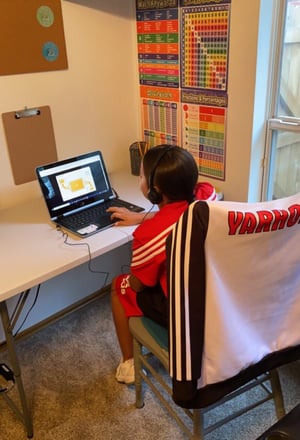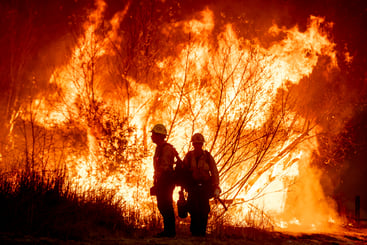A Native Perspective On Going Back To School
A Native Perspective On Going Back To School
Going back to school is usually an exciting time filled with the potential of a new school year. However, in the time of a pandemic, the thrill of new classes and new school supplies has given way to uncertainty, stress, and unique challenges facing Indigenous students.
We reached out to Courtney Tsotigh-Yarholar (Kiowa), a teacher and high school advisor for Edmond Schools Indian Education in Edmond, Oklahoma. She works in a large school district and her position is supported by the Title VI Indian Education Federal Program. We asked her a few questions to get an insider’s take on what going back to school is like in the time of COVID.
 Native Americans in Philanthropy: How is your school district approaching the upcoming school year?
Native Americans in Philanthropy: How is your school district approaching the upcoming school year?
Courtney Tsotigh-Yarholar: There are approximately 22,000 students with 2,000+ at my high school. The district is doing a hybrid and choice model. Students and families can choose whether to learn virtual or in-person face-to-face. The in-person option is blended which means students will learn in-person two days a week and virtual for three. The district has also implemented A/B day, so the number of students that would normally be on campus at one time is split in half.
The hybrid learning model is one step towards implementing safety precautions. The district is requiring masks for all students, taking temperatures of students at the beginning of the day, arranging desks to social distance, installing desk shields for teachers, and modifying procedures such as staggering passing periods and end of school day activities and pausing the practice of large student body gatherings and activities.
This is a very overwhelming set of circumstances. I think schools are doing the best they can in terms of trying to reopen and given what they have, but I still do not feel it is safe.
 Courtney Tsotigh-Yarholar (Kiowa) and her family
Courtney Tsotigh-Yarholar (Kiowa) and her family
How are you personally preparing for the upcoming school year?
The department I work for has spent this time (since March/April) working on culturally relevant, tribe specific resources to be used by teachers and students in the classroom or online. We have also been working with individuals to help us create pre-recorded videos to share with our schools. This idea came from the class I teach, as well as classrooms in our district. Normally we would invite guest speakers to share stories and experiences specific to their tribes. Many of those individuals may be elders or care-takers of elders who we would not want to expose to the classroom environment, whether or not we are taking all the safety measures possible.
How has the pandemic affected you not only as a Native person but as a Native educator?
As a Native person, part of our identity is rooted in our relationships with our extended families and friends, gathering in shared spaces, and daily practices. Those practices have been put on hold.
As an educator, I try to create a learning space rooted in the values of community and engagement. We are hands-on, with shared spaces, projects, supplies, etc. We rely on oral history and stories for our lessons. The pandemic has changed that completely.
What challenges are your students and parents now facing? What specific challenges are your Native students and parents now facing?
A couple major challenges for families are access to devices and the internet. Additionally, families may have one shared device among multiple children. Families who have the necessary tools and resources are still being met with the challenge of the balance to work, childcare, and completing school work.
Each school district's approach to how they deliver learning plans are vastly different. Many districts may not be equipped to provide one device to every student, nor can families afford this. Some tribes have been able to step-in and provide assistance to families, but not all. There is still a lot of unmet need.
There is not only a learning curve on the teachers and students switching to virtual learning platforms/software and materials, but for the parents too. I think we assume because we are a device driven society that we should be able to quickly adapt to this new way, but it is much different from a teaching and learning perspective. We also make a big assumption that all students have oversight and support from family to complete their learning.
Students and families without a pandemic struggle in a traditional school setting, add all factors now, and it’s a pretty heavy load to carry.
 Jude Scout Yarholar studying at home
Jude Scout Yarholar studying at home
What are some general sentiments that you've heard from other Native/Indigenous educators? From your Native/Indigenous community in general?
Care and concern for the safety of students.
Physical and emotional safety at home with increased domestic violence. Also, online safety such as kids taking screenshots of other kids and posting and cyberbullying. Some kids may be ashamed to share cameras due to living conditions.
Many educators are frequently assessing what the unmet needs are and re-evaluating as things continue to change.
What is one thing that you want the public to know about schools reopening in the midst of a pandemic?
With sincere intent I truly believe we are all in this together. What impacts one impacts many. Native understanding grounded in values of connection teaches us to make decisions for multi generations. The past, present, and future. While that concept may not be customary to others, as families, educators, and leaders we must embrace that practice to protect one another.
Be patient, have grace with others and ourselves, be flexible, and stay safe.
For more information on how the coronavirus pandemic is affecting Indigenous peoples and communities, including their education, please visit Native Americans in Philanthropy's COVID-19 Resource Center.



Comments